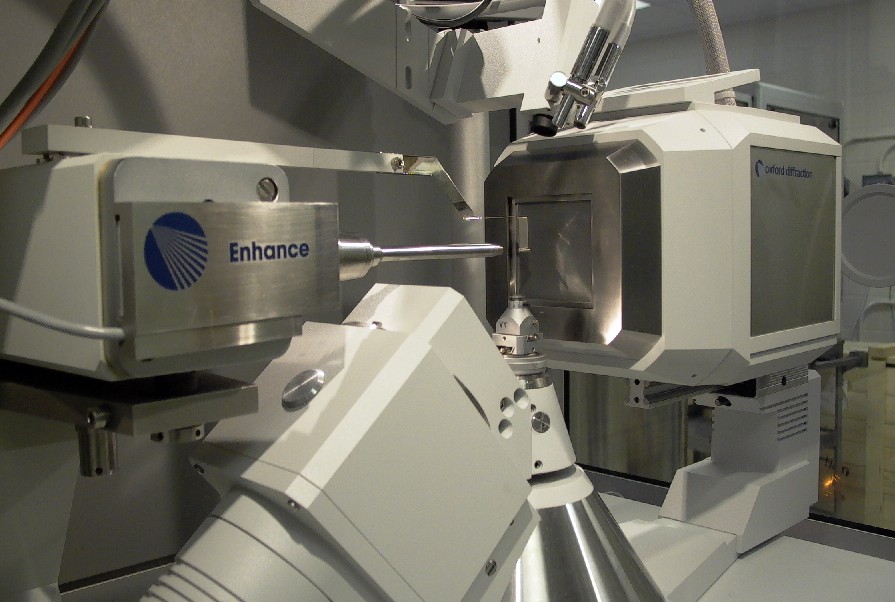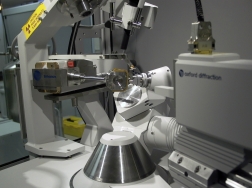

Xcalibur-2 Diffractometer

This is the Xcalibur-2 diffractometer from Oxford Diffraction, equipped with an "Enhance" optic to increase the intensity of the incident X-ray beam, and a Sapphire-III CCD camera as an area detector. This diffractometer was purchased with funds from NSF grant CHE-0131128 and upgraded to a Sapphire-III detector in 2004 with funds from the Departments of Chemistry and Geosciences, and from the College of Science.
The advantages of the kappa geometry goniometer of the Xcalibur system is the open access to the sample. This allows us to easily use a Cryojet cooling system (from Oxford Instruments), as shown in the picture. The Cryojet works by blowing a stream of nitrogen gas onto the sample, and can cool sample crystals down to a temperature of 80K. For lower temperatures we have a Helijet system from Oxford Diffraction that operates in a similar fashion, but can achieve sample temperatures as low as 10K by using helium gas as the coolant.
The Xcalibur-2 diffractometer is used mostly for structure determination of organic molecules. See the service page for details.

The Xcalibur diffractometer system was delivered and installed in September 2002. Here are some pictures from the installation. We then undertook a series of test data collections, the results of which are described below......
Ruby test dataset
In the late 1970's the International Union of Crystallography distributed a set of high-quality crystals of ruby ground into spheres of 150-200 microns on diameter. These crystals have become a standard test of data collection procedures on single-crystal X-ray diffractometers.
We used our ruby sphere to compare the Xcalibur-2 system with the Sapphire-II detector with the Xcalibur-1. Both data collections used a scan speed of 1deg/minute, generator running at 40KV/30mA; a hemisphere of reflections out to 80deg 2theta took about 21 hours in both cases. Similar quality data can be collected with the Xcalibur-2 system with significantly faster scan times.
|
Xcalibur-2 |
Xcalibur-1 |
|
Data collection details.
Combination of omega and phi scans to maximise reciprocal space coverage to
at least 80deg 2theta.
Scan speed 0.05deg/sec, frame width 1 degree, total frames 1328. |
Omega scans, 60 steps, width=1.2deg, initial speed 0.05 deg/sec Constant precision mode: to 33 I/sigma, initial rejection level 0.5 I/sigma. Minimum speed 0.005 deg/sec |
|
Data Reduction details.
Integration with the Crysalis software provided by Oxford Diffraction.
Spherical absorption correction with Absorb Averaging in -3m: Rint = 0.0131 |
|
|
Refinement. with RFINE-99 (see software)
10 refined parameters (positions, aniso displacement, scale factor and isotropic extinction) Ru = 0.020, Rw = 0.017, Gfit = 1.32 on 183* obs * In all datasets we found the 006 reflection to have Fobs>>Fcalc. We suspect that this is the result of lambda/2 diffraction from the 00 12 reflection. The 006 reflection was therefore excluded from all refinements. |
Same as the Xcalibur-2 dataset Ru = 0.013, Rw = 0.015, Gfit = 0.95 on 176* obs |
|
Results.
Al-O bond lengths: 1.8553(3)A and 1.9714(4)A
Al-O-Al and O-Al-O bond angles agree within 0.01deg between the two refinements. The orientation of the anisotropic displacement ellipsoid for the O atom differs by 2.5 degrees between the two refinements. |
1.8553(2)A and 1.9715(3)A |